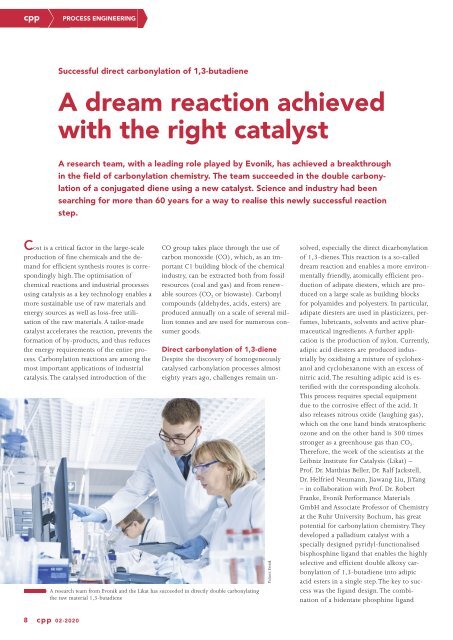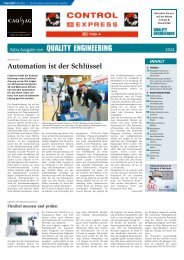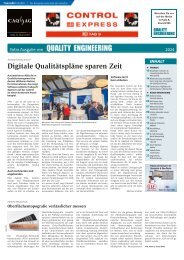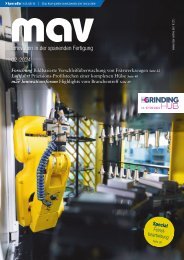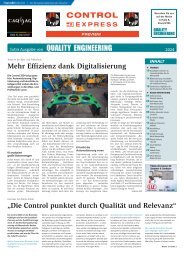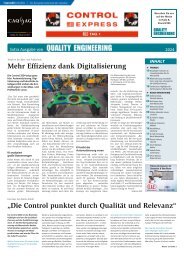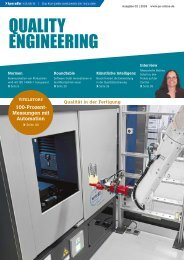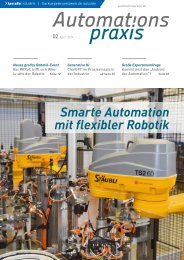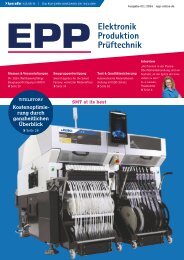cpp – Process technology for the chemical industry 02.2020
The journal cpp - Process technology for the chemical industry reports about processes, plants, apparatus and components for the chemical and pharmaceutical industry. Further topics are IT technologies, industry 4.0, digital production, MSR and automation technology and process analysis technology. The content spectrum is rounded off by explosion protection, plant safety, occupational health and safety, maintenance, site management and energy management.
The journal cpp - Process technology for the chemical industry reports about processes, plants, apparatus and components for the chemical and pharmaceutical industry. Further topics are IT technologies, industry 4.0, digital production, MSR and automation technology and process analysis technology. The content spectrum is rounded off by explosion protection, plant safety, occupational health and safety, maintenance, site management and energy management.
You also want an ePaper? Increase the reach of your titles
YUMPU automatically turns print PDFs into web optimized ePapers that Google loves.
<strong>cpp</strong><br />
PROCESS ENGINEERING<br />
Successful direct carbonylation of 1,3-butadiene<br />
A dream reaction achieved<br />
with <strong>the</strong> right catalyst<br />
A research team, with a leading role played by Evonik, has achieved a breakthrough<br />
in <strong>the</strong> field of carbonylation chemistry. The team succeeded in <strong>the</strong> double carbonylation<br />
of a conjugated diene using a new catalyst. Science and <strong>industry</strong> had been<br />
searching <strong>for</strong> more than 60 years <strong>for</strong> a way to realise this newly successful reaction<br />
step.<br />
Cost is a critical factor in <strong>the</strong> large-scale<br />
production of fine <strong>chemical</strong>s and <strong>the</strong> demand<br />
<strong>for</strong> efficient syn<strong>the</strong>sis routes is correspondingly<br />
high. The optimisation of<br />
<strong>chemical</strong> reactions and industrial processes<br />
using catalysis as a key <strong>technology</strong> enables a<br />
more sustainable use of raw materials and<br />
energy sources as well as loss-free utilisation<br />
of <strong>the</strong> raw materials. A tailor-made<br />
catalyst accelerates <strong>the</strong> reaction, prevents <strong>the</strong><br />
<strong>for</strong>mation of by-products, and thus reduces<br />
<strong>the</strong> energy requirements of <strong>the</strong> entire process.<br />
Carbonylation reactions are among <strong>the</strong><br />
most important applications of industrial<br />
catalysis. The catalysed introduction of <strong>the</strong><br />
CO group takes place through <strong>the</strong> use of<br />
carbon monoxide (CO), which, as an important<br />
C1 building block of <strong>the</strong> <strong>chemical</strong><br />
<strong>industry</strong>, can be extracted both from fossil<br />
resources (coal and gas) and from renewable<br />
sources (CO 2 or biowaste). Carbonyl<br />
compounds (aldehydes, acids, esters) are<br />
produced annually on a scale of several million<br />
tonnes and are used <strong>for</strong> numerous consumer<br />
goods.<br />
A research team from Evonik and <strong>the</strong> Likat has succeeded in directly double carbonylating<br />
<strong>the</strong> raw material 1,3-butadiene<br />
Pictures: Evonik<br />
Direct carbonylation of 1,3-diene<br />
Despite <strong>the</strong> discovery of homogeneously<br />
catalysed carbonylation processes almost<br />
eighty years ago, challenges remain unsolved,<br />
especially <strong>the</strong> direct dicarbonylation<br />
of 1,3-dienes. This reaction is a so-called<br />
dream reaction and enables a more environmentally<br />
friendly, atomically efficient production<br />
of adipate diesters, which are produced<br />
on a large scale as building blocks<br />
<strong>for</strong> polyamides and polyesters. In particular,<br />
adipate diesters are used in plasticizers, perfumes,<br />
lubricants, solvents and active pharmaceutical<br />
ingredients. A fur<strong>the</strong>r application<br />
is <strong>the</strong> production of nylon. Currently,<br />
adipic acid diesters are produced industrially<br />
by oxidising a mixture of cyclohexanol<br />
and cyclohexanone with an excess of<br />
nitric acid. The resulting adipic acid is esterified<br />
with <strong>the</strong> corresponding alcohols.<br />
This process requires special equipment<br />
due to <strong>the</strong> corrosive effect of <strong>the</strong> acid. It<br />
also releases nitrous oxide (laughing gas),<br />
which on <strong>the</strong> one hand binds stratospheric<br />
ozone and on <strong>the</strong> o<strong>the</strong>r hand is 300 times<br />
stronger as a greenhouse gas than CO 2 .<br />
There<strong>for</strong>e, <strong>the</strong> work of <strong>the</strong> scientists at <strong>the</strong><br />
Leibniz Institute <strong>for</strong> Catalysis (Likat) <strong>–</strong><br />
Prof. Dr. Matthias Beller, Dr. Ralf Jackstell,<br />
Dr. Helfried Neumann, Jiawang Liu, JiYang<br />
<strong>–</strong> in collaboration with Prof. Dr. Robert<br />
Franke, Evonik Per<strong>for</strong>mance Materials<br />
GmbH and Associate Professor of Chemistry<br />
at <strong>the</strong> Ruhr University Bochum, has great<br />
potential <strong>for</strong> carbonylation chemistry. They<br />
developed a palladium catalyst with a<br />
specially designed pyridyl-functionalised<br />
bisphosphine ligand that enables <strong>the</strong> highly<br />
selective and efficient double alkoxy carbonylation<br />
of 1,3-butadiene into adipic<br />
acid esters in a single step. The key to success<br />
was <strong>the</strong> ligand design. The combination<br />
of a bidentate phosphine ligand<br />
8 <strong>cpp</strong> 02-2020


